Pedometer Use - Counting Steps Guide for Fitness and Weight loss
Pedometers, also known as step-counters, count the strides and 'step' movements that you make walking, jogging, running, or during gym workouts. They are available as stand-alone devices or as apps for mobile devices and use various mechanisms to detect movements.
Traditionally people have used time and distance travelled as a measure of the amount of exercise they have performed. Similarly, people interested in losing weight or controlling their weight have used exercise times, speeds and distance travelled as a measure of the number of calories they have burnt during a session.
However, it is hard to add up all the exercise sessions you complete during the day and to get a measure of your total calorie consumption.
Pedometers offer a simple solution to these problems. The steps can be converted into calories burnt and amount of weight lost as pounds and kilograms independent of pace and distance.
This article will show you how this is done by reviewing the relationship between exercise rate and speed for walking, running and cycling and providing charts of the number ofsteps required to lose a pound or a kilogram of fat.
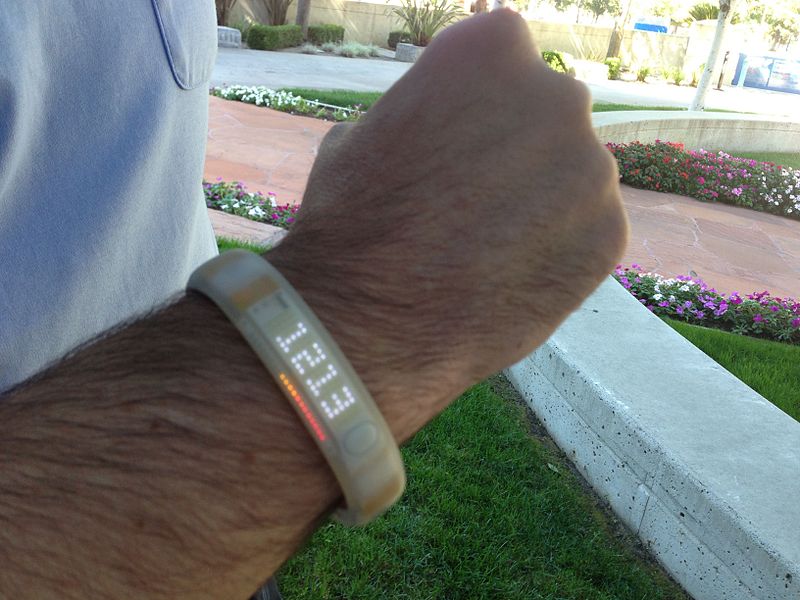
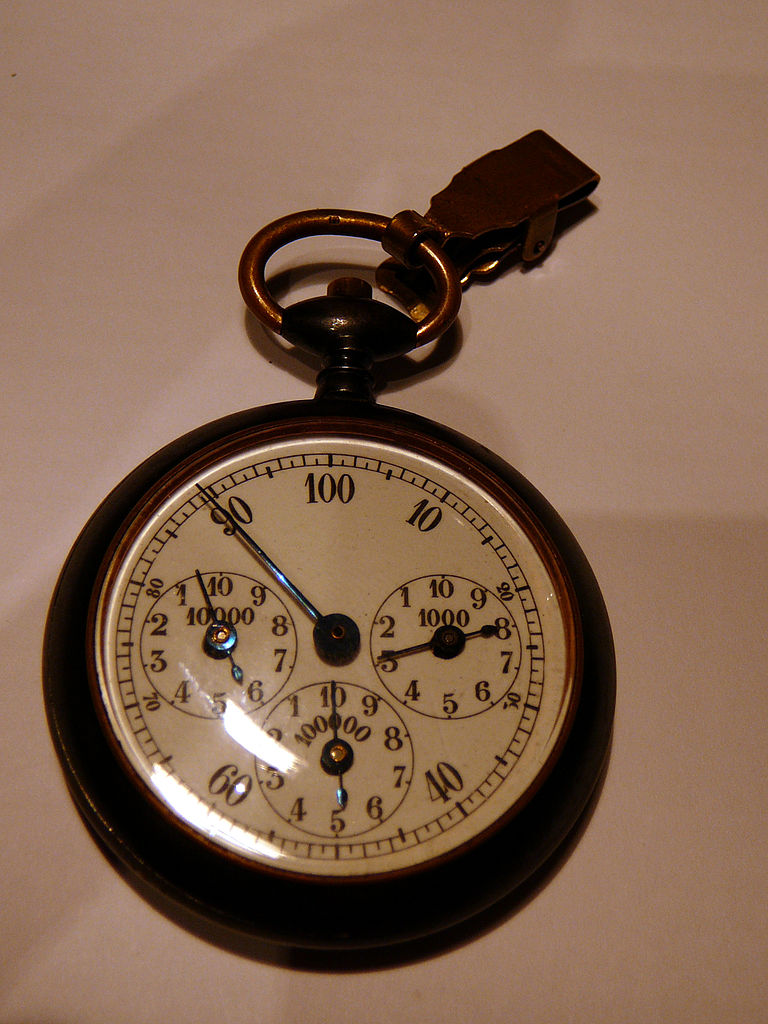
What are the Benefits of Pedometers?
A review of various pedometer research studies showed that:
► People who used increased their physical activity by for than 25%.
► Setting a daily step goal of 10,000 steps per day tended to increase the daily exercise rate.
► People tended to progress towards this goal and to keep exercising at that rate.
► Pedometer users significantly decreased their body mass index by 0.38, when they had a step goal.
► Pedometer users significant decreased their blood pressure.
Another study of how pedometers can motivate people to lose weight and exercise more towards a goal found that:
► Pedometers were viewed as reliable and valuable devices which helped motivate people and provided a simple powerful tool for monitoring progress towards self-defined exercise and weight-loss goals.
Great Debate About the Exercise Rate and Energy Expenditure (Calories Burnt)
There is an unresolved debate about whether the amount of energy expended in walking, running and cycling over the same distance is dependent on how fast you go. If you go faster the rate of calorie burnt will increase as you are expending more energy. But you will arrive at the destination quicker and so you will exercise for a shorter period of time at the higher rate. This is the classic 'hare' and 'tortoise' race. The two sides of the argument are:
► It makes no difference how fast you go, the distance traveled will be the same and the total energy consumed will be the same.
► Walking, running and cycling at a faster pace burns more calories pushing harder against the wind. Your muscles have to work harder and so the energy consumed will be greater if you exercise at a higher rate and pace. There are other benefits of working out at higher rates and intensities which is well covered by various articles.
Why does this matter? Pedometers and the steps they count are essentially independent of the speed or rate at which you walk run or cycle. Though if you keep track of exercise times, pedometers can be used to measure and monitor your pace and speed. Stride length also tends to increase with speed, especially when shifting from a slow walk, to a fast run, and this can affect the relationship between steps and energy expended.
Eating Less or Exercising More - Which is the Best Method of Losing Weight?
There is a lot of emphasis on exercise as a weight loss method especially on programs such as 'The Biggest Loser'. But how much exercise is required? It would be useful to develop rule of thumb estimates for:
► Number of Walking Steps required to lose 1 lb and 1kg of weight
► Number of Running Steps required to lose 1 lb and 1kg of weight
What is the best method for losing weight for a set distance of daily exercise such as 10 miles, 16 kilometers?
The answers to these questions is provided below.
How many steps per day are enough for general health?
The following pedometer-measured physical activity index has been proposed:
► Sedentary - less than 5,000 steps per day
► Low Activity - 5,000-7,500 steps a day
► Moderately Active - 7,500-9,900 steps a day
► Active - 10,000 -12,500 steps a day
► Highly Active - 12,5000 steps a day
How does Walking Running and Cycling Compare with Other Sports and Activities?
The image below compares the calorie expenditure rate for various activities and below is a comparison of the calorie burn rates for walking, running and cycling at various speeds.
Calories per Mile for a 160 Pound Person
Walking
- 2.0 mph - 91 calories per mile
- 2.5 mph - 87 calories per mile
- 3.0 mph - 85 calories per mile
- 3.5 mph - 83 calories per mile
- 4.0 mph - 91 calories per mile
- 4.5 mph - 102 calories per mile
- 5.0 mph - 116 calories per mile
Running
- 5.0 mph - 116 calories per mile
- 6.0 mph - 121 calories per mile
- 7.0 mph - 119 calories per mile
- 8.0 mph - 123 calories per mile
- 9.0 mph - 121 calories per mile
- 10.0 mph - 131 calories per mile
Cycling
- 10.0 mph 26 calories per mile
- 15.0 mph 31 calories per mile
- 20.0 mph 38 calories per mile
- 25.0 mph 47 calories per mile
- 30.0 mph 59 calories per mile
The burn rate depends on the weight of the person. Heavier people burn calories at a higher rate as they are pushing against gravity!
The simple formulae below can be used to estimate your calorie burn rate per mile for speeds of about 3-5 mph (8 kph). Simply enter your weight to derive an estimate for walking and running.
Miles
Running (calories burnt per mile)
0.75 x your weight (in lbs)
1.5 x your weight (in kg)
Walking (calories burnt per mile)
0.53 x your weight (in lbs)
1.0 x your weight (in kg)
Kilometers
Running (calories burnt per km)
0.45 x your weight (in lbs)
0.9 x your weight (in kg)
Walking (calories burnt per km)
0.33 x your weight (in lbs)
0.66 x your weight (in kg)
Calorie Burn Rate per Hour for Various Activities
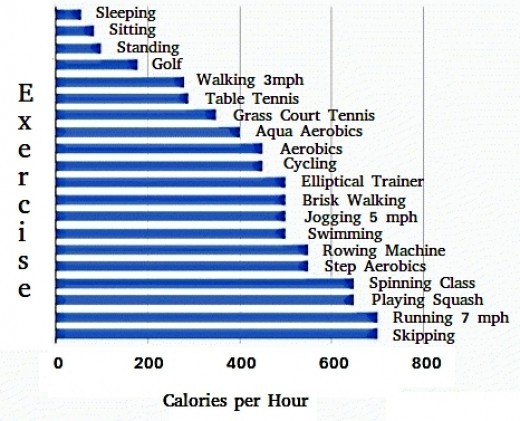
Converting Calories Burnt to Pounds and Kilograms of Fat Potentially Lost
► One pound of fat is equivalent to 3,500 calories.
► One kilogram of fat is equivalent to 7,000 calories
Step equivalents as steps per minute for various activities can be derived from the calorie burn rates.
Knowing the calories in a pound and kilogram of fat and the calorie burnt rates at steps we can estimate the number of hours of exercise of various types to burn one pound of fat and one kilogram of fat.
The two tables at the end of the article summarize this information.
The extract below shows that the hours required to burn one pound of fat is large, perhaps longer than most people expected. For slow walking it is about 6 hours, brisk walking/jogging - 4 hours, Fast running - 1.5 hours, cycling moderately fast - 3 hours, fast cycling 2.5 hours.
Clearly, exercising to lose weight is a lot of work. You can lose the same number of calories by starving for two days, as most people consume 2500-3000 calories a day.
Steps Required to Lose Fat
Using the data in the table below we can estimate the number of steps required to lose a pound of weight (3,500 calories). As shown below the rate at which the exercise is done (the intensity) does make a difference, but the effect is relatively small except for walking. This means that we can estimate the number of steps or step equivalents required to lose one pound and one kilogram of fat. It varies with body weight. Once again the effort required is larger than most people expect compared with dieting
Steps Required to Lose 1 lb (500 g) of Fat
► Body weight 290 lb - 44,000 steps (about 4 days at 10,000 steps per day)
► Body weight 270 lb - 48,000 steps (about 5 days at 10,000 steps per day)
► Body weight 250 lb - 51,000 steps (about 5 days at 10,000 steps per day)
► Body weight 230 lb - 56,000 steps (about 6 days at 10,000 steps per day)
► Body weight 210 lb - 61,000 steps (about 6 days at 10,000 steps per day)
► Body weight 190 lb - 74,000 steps (about 7 days at 10,000 steps per day)
The estimates for kilograms are:
Steps Required to Lose 1 kg of Fat
► Body weight 145 kg - 85,000 steps (about 8 days at 10,000 steps per day)
► Body weight 135 kg - 91,000 steps (about 9 days at 10,000 steps per day)
► Body weight 125 kg - 98,000 steps (about 10 days at 10,000 steps per day)
► Body weight 115 kg - 110,000 steps (about 11 days at 10,000 steps per day)
► Body weight 105 kg - 120,000 steps (about 12 days at 10,000 steps per day)
Hours of Various Activities Required by 290 lb person to burn one pound of fat
| Exercise | Steps per minute equivalent | Hours for person weighing 290 lb to burn one pound of fat with the exercise |
|---|---|---|
| Walking 2 mph | 67 steps/minute | 9.6 hours |
| Walking 3 mph | 100 steps/minute | 6.1 hours |
| Walking 4 mph | 152 steps/minute | 5.2 hours |
| Walking 5 mph | 242 steps/minute | 4.3 hours |
| Running 8 mph | 409 steps/minute | 2 hours |
| Running 10 mph | 420 steps/minute | 1.5 hours |
| Bicycling / biking - mountain | 364 steps/minute | 3.1 hours |
| Bicycling / cycling 12-14 mph | 121 steps/minute | 3 hours |
| Bicycling / cycling 14-16 mph | 364 steps/minute | 2.5 hours |
| Swimming - moderate | 212 steps/minute | 4.4 hours |
| Swimming - vigorous | 303 steps/minute | 2.7 hours |
| Aerobics | 242 steps/minute | 3.8 hours |
| Calisthenics / exercise - vigorous | 242 steps/minute | 3.3 hours |
| Frisbee playing | 91 steps/minute | 8.7 hours |
| Gardening | 121 steps/minute | 4.9 hours |
| Golf - carry clubs | 136 steps/minute | 4.4 hours |
| Hiking | 182 steps/minute | 4.5 hours |
| Hockey | 242 steps/minute | 3.3 hours |
| Rowing machine - moderate | 212 steps/minute | 3.8 hours |
| Rowing machine - vigorous | 258 steps/minute | 3 hours |
| Skiing - cross country | 242 steps/minute | 2.3 hours |
| Skiing - downhill | 182 steps/minute | 3 hours |
| Snorkeling | 152 steps/minute | 5 hours |
| Soccer | 212 steps/minute | 2.6 hours |
| Softball or baseball | 152 steps/minute | 5.3 hours |
| Step aerobics | 273 steps/minute | 2.5 hours |
| Table tennis | 121 steps/minute | 6.7 hours |
| Tennis - doubles | 212 steps/minute | 6.3 hours |
| Tennis - singles | 240 steps/minute | 4.4 hours |
| Volleyball | 121 steps/minute | 7.7 hours |
| Water Aerobics | 121 steps/minute | 11.8 hours |
| Lifting Weights - general | 121 steps/minute | 7.2 hours |
| Lifting Weights - vigorous | 182 steps/minute | 7.7 hours |
How Does the Type of Exercise and Speed or Rate Affect the Calories Burnt Over a Fixed Distance
There is a lot of debate about whether running, walking or cycling over a fixed distance of 10 miles, for example, burns more calories when done at a faster pace. Going faster consumes more calories, but you complete the task faster. The data used for these comparisons may also be unreliable. The images below provide some of the evidence. The major point derived from this are:
Cycling is much more efficient and burns much less calories than walking or running over a range of 'reasonable' speeds.
There is some evidence that the energy burn rate for cycling increases with speed but the differences are relatively small - 30% difference from slow to fast.
The total calories burnt when running a fixed distance appears to be unrelated to speed (apart from small difference.
Walking is the major exception. Bisk and Fast Walking consumes more calories than walking slowly. Walking is most efficient - requiring less energy per mile - at about 3-4 miles per hour. Walking at 7 mph requires twice as much energy as walking at 3 miles per hour.
Conclusion: Brisk Walking is a Good Exercise for Losing weight compared to Walking Slowly
Energy Expenditure Rates for Cycling, Running and Walking and energy consumed for a 10 mile workout y person weighting 180 lb
| Activity, Speed | Calories per hour for 180 lb person | Calories Burnt for distance of 10 miles |
|---|---|---|
| cycle 6 mph | 327 | 545 |
| cycle 10 mph | 490 | 490 |
| cycle 13 mph | 654 | 503 |
| cycle 15 mph | 817 | 545 |
| cycle 18 mph | 981 | 545 |
| cycle 25 mph | 1308 | 523 |
| run 5 mph | 654 | 1308 |
| run 5.2 mph | 735 | 1413 |
| run 6 mph | 817 | 1362 |
| run 6.7 mph | 899 | 1342 |
| run 7 mph | 940 | 1343 |
| run 7.5 mph | 1022 | 1363 |
| run 8 mph | 1103 | 1379 |
| run 8.6 mph | 1144 | 1330 |
| run 9 mph | 1226 | 1362 |
| run 10 mph | 1308 | 1308 |
| run 10.9 mph | 1471 | 1350 |
| walk 1 mph | 163 | 1630 |
| walk 2 mph | 204 | 1020 |
| walk 2.5 mph | 245 | 980 |
| walk 3 mph | 270 | 900 |
| walk 3.5 mph | 311 | 889 |
| walk 4 mph | 409 | 1023 |
| walk 4.5 mph | 515 | 1144 |
| walk 5 mph | 654 | 1308 |
Calorie burn rates for various speeds walking, running and cycling
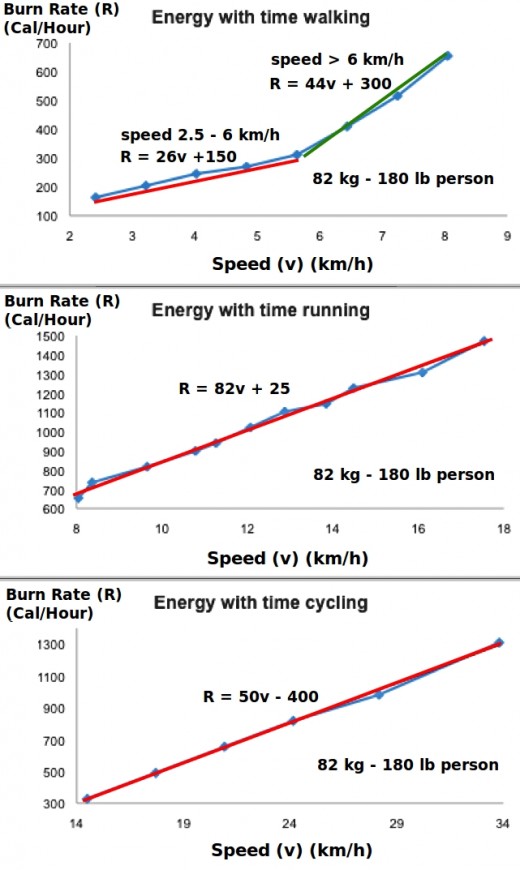
Calorie burn rates for 10 km of walking, running and cycling
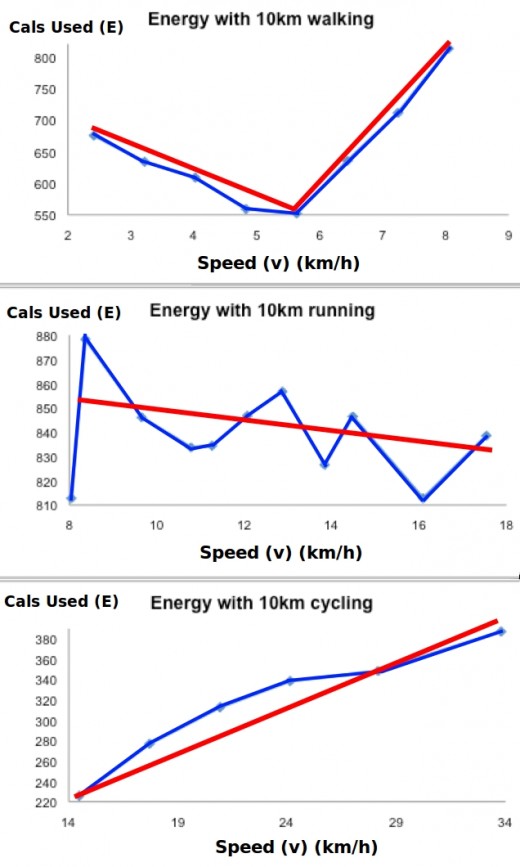
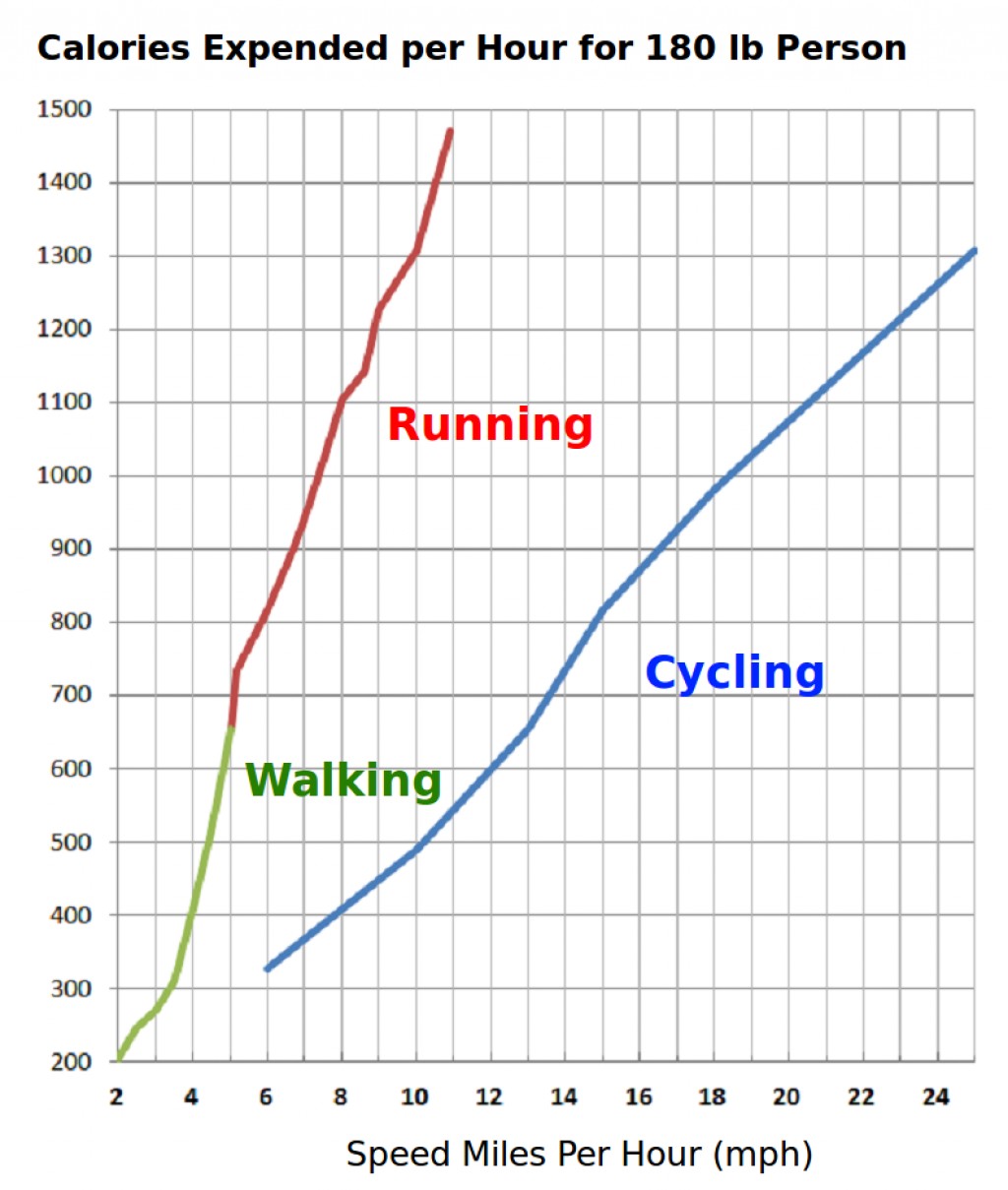
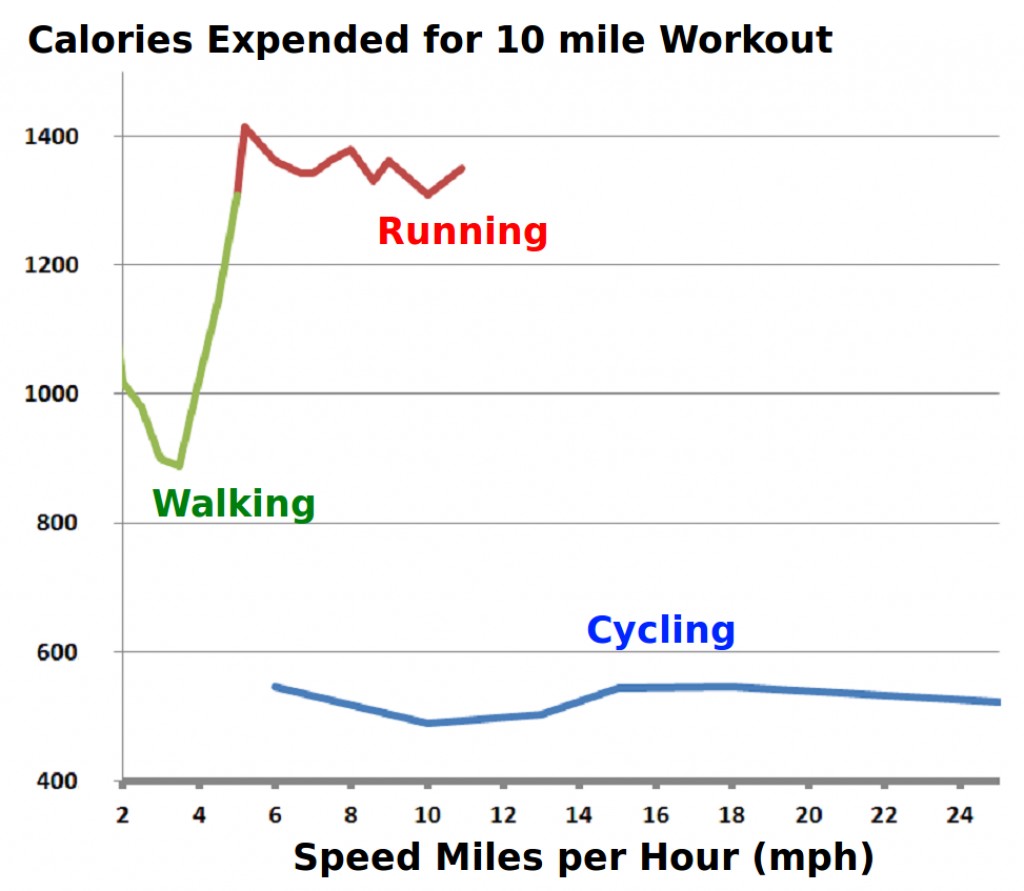
Hours and Steps Required to Lose one pound of Body Weight for People of Various Sizes
| Activity | Steps per Minute (equiv) | Hours to lose one pound (body weight 290 lb); 44000 steps | Hours to lose one pound (body weight 270 lb); 48000 steps | Hours to lose one pound (body weight 250 lb); 51000 steps | Hours to lose one pound (body weight 230 lb); 56000 steps | Hours to lose one pound (body weight 210 lb); 61000 steps | Hours to lose one pound (body weight 190 lb); 74000 steps |
|---|---|---|---|---|---|---|---|
| Walking 2 mph | 67 | 9.6 | 10.3 | 11.1 | 12.1 | 13.2 | 14.6 |
| Walking 3 mph | 100 | 6.1 | 6.5 | 7.1 | 7.7 | 8.4 | 9.3 |
| Walking 4 mph | 152 | 5.2 | 5.5 | 6 | 6.5 | 7.1 | 7.9 |
| Walking 5 mph | 242 | 4.3 | 4.6 | 5 | 5.4 | 5.9 | 6.6 |
| Running 10 mph (6 Hours miles) | 420 | 1.5 | 1.6 | 1.7 | 1.9 | 2 | 2.3 |
| Running 12 mph (5 Hours miles) | 440 | 1.2 | 1.3 | 1.4 | 1.5 | 1.6 | 1.8 |
| Running 5 mph (12 Hours miles) | 242 | 3.1 | 3.4 | 3.6 | 4 | 4.3 | 4.8 |
| Running 6 mph (10 Hours miles) | 303 | 2.6 | 2.8 | 3.1 | 3.3 | 3.7 | 4 |
| Running 7 mph (8.5 Hours miles) | 348 | 2.3 | 2.5 | 2.7 | 2.9 | 3.2 | 3.5 |
| Running 8 mph (7.5 Hours miles) | 409 | 2 | 2.1 | 2.3 | 2.5 | 2.7 | 3 |
| Bicycling / biking - mountain | 364 | 3.1 | 3.4 | 3.6 | 4 | 4.3 | 4.8 |
| Bicycling / cycling 12-14 mph | 121 | 3 | 3.3 | 3.5 | 3.8 | 4.2 | 4.7 |
| Bicycling / cycling 14-16 mph | 364 | 2.5 | 2.7 | 2.9 | 3.2 | 3.5 | 3.8 |
| Stationary bicycle / spinning - moderate | 212 | 3.8 | 4.1 | 4.4 | 4.8 | 5.2 | 5.8 |
| Stationary bicycle / spinning - vigorous | 318 | 2.3 | 2.5 | 2.7 | 2.9 | 3.2 | 3.6 |
| Swimming - moderate | 212 | 4.4 | 4.7 | 5.1 | 5.5 | 6 | 6.7 |
| Swimming - vigorous | 303 | 2.7 | 2.9 | 3.2 | 3.4 | 3.8 | 4.1 |
| Aerobics - high impact | 242 | 3.8 | 4.1 | 4.4 | 4.8 | 5.2 | 5.8 |
| Aerobics - low impact | 197 | 4.4 | 4.7 | 5.1 | 5.5 | 6 | 6.7 |
| Badminton | 136 | 5.9 | 6.4 | 6.9 | 7.5 | 8.2 | 9 |
| Basketball - shooting baskets | 136 | 5.9 | 6.4 | 6.9 | 7.5 | 8.2 | 9 |
| Basketball full court | 242 | 2.4 | 2.6 | 2.8 | 3.1 | 3.3 | 3.7 |
| Bowling | 91 | 8.7 | 9.4 | 10.1 | 11 | 12.1 | 13.3 |
| Calisthenics / exercise - moderate | 106 | 5.9 | 6.4 | 6.9 | 7.5 | 8.2 | 9 |
| Calisthenics / exercise - vigorous | 242 | 3.3 | 3.5 | 3.8 | 4.2 | 4.6 | 5 |
| Cooking | 61 | 10.1 | 10.8 | 11.7 | 12.7 | 13.9 | 15.4 |
| Croquet | 76 | 10.6 | 11.4 | 12.3 | 13.3 | 14.6 | 16.2 |
| Fencing | 182 | 4.5 | 4.8 | 5.2 | 5.6 | 6.2 | 6.8 |
| Fishing | 91 | 8.7 | 9.4 | 10.1 | 11 | 12.1 | 13.3 |
| Football - full contact | 242 | 2.8 | 3 | 3.2 | 3.5 | 3.8 | 4.2 |
| Frisbee playing | 91 | 8.7 | 9.4 | 10.1 | 11 | 12.1 | 13.3 |
| Garden | 121 | 4.9 | 5.3 | 5.7 | 6.2 | 6.8 | 7.5 |
| Golf - carry clubs | 136 | 4.4 | 4.7 | 5.1 | 5.5 | 6 | 6.7 |
| Golf - pull cart | 120 | 5.9 | 6.4 | 6.9 | 7.5 | 8.2 | 9 |
| Handball | 364 | 2.2 | 2.4 | 2.6 | 2.8 | 3.1 | 3.4 |
| Hiking | 182 | 4.5 | 4.8 | 5.2 | 5.6 | 6.2 | 6.8 |
| Hockey | 242 | 3.3 | 3.5 | 3.8 | 4.2 | 4.6 | 5 |
| Horseback riding | 121 | 10.6 | 11.4 | 12.3 | 13.3 | 14.6 | 16.2 |
| Hunting | 152 | 5.3 | 5.7 | 6.1 | 6.7 | 7.3 | 8.1 |
| Jogging | 212 | 3.8 | 4.1 | 4.4 | 4.8 | 5.2 | 5.8 |
| Jumping jacks - moderate | 303 | 5.9 | 6.4 | 6.9 | 7.5 | 8.2 | 9 |
| Kayaking | 152 | 5.3 | 5.7 | 6.1 | 6.7 | 7.3 | 8.1 |
| Lacrosse | 242 | 3.1 | 3.4 | 3.6 | 4 | 4.3 | 4.8 |
| Racquetball casual | 212 | 3.8 | 4.1 | 4.4 | 4.8 | 5.2 | 5.8 |
| Raking lawn | 121 | 6.7 | 7.2 | 7.8 | 8.5 | 9.3 | 10.2 |
| Rowing machine - moderate | 212 | 3.8 | 4.1 | 4.4 | 4.8 | 5.2 | 5.8 |
| Rowing machine - vigorous | 258 | 3 | 3.3 | 3.5 | 3.8 | 4.2 | 4.7 |
| Rugby | 303 | 2.5 | 2.7 | 2.9 | 3.2 | 3.5 | 3.8 |
| Shopping | 70 | 11.2 | 12 | 13 | 14.1 | 15.4 | 17.1 |
| Sitting / resting | 30 | 25.1 | 27 | 29.2 | 31.7 | 34.7 | 38.4 |
| Skateboarding | 152 | 5.3 | 5.7 | 6.1 | 6.7 | 7.3 | 8.1 |
| Skating – moderate (ice) | 264 | 5.3 | 5.7 | 6.1 | 6.7 | 7.3 | 8.1 |
| Skating (ice) – vigorous Inline Skating | 364 | 2.9 | 3.1 | 3.4 | 3.7 | 4 | 4.4 |
| Ski machine | 212 | 2.8 | 3 | 3.2 | 3.5 | 3.8 | 4.2 |
| Skiing - cross country | 242 | 2.3 | 2.5 | 2.7 | 2.9 | 3.2 | 3.6 |
| Skiing - downhill | 182 | 3 | 3.3 | 3.5 | 3.8 | 4.2 | 4.7 |
| Snorkeling | 152 | 5 | 5.4 | 5.8 | 6.3 | 6.9 | 7.7 |
| Soccer competitive | 212 | 2.6 | 2.8 | 3.1 | 3.3 | 3.7 | 4 |
| Softball or baseball | 152 | 5.3 | 5.7 | 6.1 | 6.7 | 7.3 | 8.1 |
| Step aerobics | 273 | 2.5 | 2.7 | 2.9 | 3.2 | 3.5 | 3.8 |
| Table tennis | 121 | 6.7 | 7.2 | 7.8 | 8.5 | 9.3 | 10.2 |
| Tennis - doubles | 212 | 6.3 | 6.8 | 7.3 | 7.9 | 8.7 | 9.6 |
| Tennis - singles | 240 | 4.4 | 4.7 | 5.1 | 5.5 | 6 | 6.7 |
| Volleyball | 121 | 7.7 | 8.3 | 9 | 9.8 | 10.7 | 11.8 |
| Water Aerobics | 121 | 11.8 | 12.7 | 13.7 | 14.9 | 16.3 | 18.1 |
| Lifting Weights - general | 121 | 7.2 | 7.7 | 8.3 | 9.1 | 9.9 | 11 |
| Lifting Weights - vigorous | 182 | 7.7 | 8.3 | 9 | 9.8 | 10.7 | 11.8 |
Hours and Steps Required to Lose one kilogram of Body Weight for People of Various Sizes
| Activity | Steps per Minute (equiv) | Hours to lose one kilogram (body weight 145 kg); 85000 steps | Hours to lose one kilogram (body weight 135 kg); 91000 steps | Hours to lose one kilogram (body weight 125 kg); 98000 steps | Hours to lose one kilogram (body weight 115 kg); 110000 steps | Hours to lose one kilogram (body weight 105 kg); 120000 steps |
|---|---|---|---|---|---|---|
| Walking 3.2 kph | 67 | 19.1 | 20.5 | 22.2 | 24.1 | 26.4 |
| Walking 4.8 kph | 100 | 12.2 | 13.1 | 14.1 | 15.3 | 16.8 |
| Walking 6.4 kph | 152 | 10.3 | 11.1 | 11.9 | 13 | 14.2 |
| Running 8 kph | 242 | 6.3 | 6.7 | 7.3 | 7.9 | 8.7 |
| Running 9.6 kph | 303 | 5.3 | 5.7 | 6.1 | 6.7 | 7.3 |
| Running 11.2 kph | 348 | 4.6 | 5 | 5.4 | 5.8 | 6.4 |
| Running 12.8 kph | 409 | 3.9 | 4.2 | 4.6 | 5 | 5.4 |
| Running 16 kph | 420 | 3 | 3.2 | 3.4 | 3.7 | 4.1 |
| Running 19.2 kph | 440 | 2.4 | 2.6 | 2.8 | 3 | 3.3 |
| Bicycling - Mountain | 364 | 6.3 | 6.7 | 7.3 | 7.9 | 8.7 |
| Bicycling 19.2-22.4 kph | 121 | 6.1 | 6.5 | 7.1 | 7.7 | 8.4 |
| Bicycling 22.4-25.6 kph | 364 | 5 | 5.4 | 5.8 | 6.3 | 6.9 |
| Stationary Bicycle - moderate | 212 | 7.6 | 8.1 | 8.8 | 9.6 | 10.5 |
| Stationary Bicycle - vigorous | 318 | 4.7 | 5 | 5.4 | 5.9 | 6.4 |
| Swimming - moderate | 212 | 8.7 | 9.4 | 10.1 | 11 | 12.1 |
| Swimming - vigorous | 303 | 5.4 | 5.8 | 6.3 | 6.8 | 7.5 |
| Aerobics - high impact | 242 | 7.6 | 8.1 | 8.8 | 9.6 | 10.5 |
| Aerobics - low impact | 197 | 8.7 | 9.4 | 10.1 | 11 | 12.1 |
| Badminton | 136 | 11.8 | 12.7 | 13.7 | 14.9 | 16.3 |
| Basketball - shooting baskets | 136 | 11.8 | 12.7 | 13.7 | 14.9 | 16.3 |
| Basketball full court | 242 | 4.8 | 5.2 | 5.6 | 6.1 | 6.7 |
| Bowling | 91 | 17.5 | 18.7 | 20.2 | 22 | 24.1 |
| Calisthenics - moderate | 106 | 11.8 | 12.7 | 13.7 | 14.9 | 16.3 |
| Calisthenics - vigorous | 242 | 6.6 | 7.1 | 7.6 | 8.3 | 9.1 |
| Cooking | 61 | 20.1 | 21.6 | 23.3 | 25.3 | 27.7 |
| Croquet | 76 | 21.1 | 22.7 | 24.5 | 26.6 | 29.2 |
| Fencing | 182 | 8.9 | 9.6 | 10.3 | 11.2 | 12.3 |
| Fishing | 91 | 17.5 | 18.7 | 20.2 | 22 | 24.1 |
| Football - full contact | 242 | 5.5 | 5.9 | 6.4 | 6.9 | 7.6 |
| Frisbee playing | 91 | 17.5 | 18.7 | 20.2 | 22 | 24.1 |
| Garden | 121 | 9.8 | 10.5 | 11.4 | 12.3 | 13.5 |
| Golf - carry clubs | 136 | 8.7 | 9.4 | 10.1 | 11 | 12.1 |
| Golf - cart | 120 | 15.4 | 16.6 | 17.9 | 19.5 | 21.3 |
| Handball | 364 | 4.4 | 4.7 | 5.1 | 5.6 | 6.1 |
| Hiking | 182 | 8.9 | 9.6 | 10.3 | 11.2 | 12.3 |
| Hockey | 242 | 6.6 | 7.1 | 7.6 | 8.3 | 9.1 |
| Horseback riding - walking | 121 | 21.1 | 22.7 | 24.5 | 26.6 | 29.2 |
| Hunting | 152 | 10.6 | 11.3 | 12.3 | 13.3 | 14.6 |
| Jogging | 212 | 7.6 | 8.1 | 8.8 | 9.6 | 10.5 |
| Kayaking | 152 | 10.6 | 11.3 | 12.3 | 13.3 | 14.6 |
| Lacrosse | 242 | 6.3 | 6.7 | 7.3 | 7.9 | 8.7 |
| Racquetball casual | 212 | 7.6 | 8.1 | 8.8 | 9.6 | 10.5 |
| Raking lawn | 121 | 13.4 | 14.4 | 15.5 | 16.9 | 18.5 |
| Rowing Machine - moderate | 212 | 7.6 | 8.1 | 8.8 | 9.6 | 10.5 |
| Rowing Machine - vigorous | 258 | 6.1 | 6.5 | 7.1 | 7.7 | 8.4 |
| Rugby | 303 | 5 | 5.4 | 5.8 | 6.3 | 6.9 |
| Shopping | 70 | 22.3 | 24 | 25.9 | 28.1 | 30.8 |
| Sitting | 30 | 50.2 | 53.9 | 58.2 | 63.3 | 69.3 |
| Skateboarding | 152 | 10.6 | 11.3 | 12.3 | 13.3 | 14.6 |
| Skating - moderate | 264 | 10.6 | 11.3 | 12.3 | 13.3 | 14.6 |
| Skating - vigorous | 364 | 5.8 | 6.2 | 6.7 | 7.3 | 8 |
| Ski Machine | 212 | 5.5 | 5.9 | 6.4 | 6.9 | 7.6 |
| Skiing - cross country | 242 | 4.7 | 5 | 5.4 | 5.9 | 6.4 |
| Skiing - downhill | 182 | 6.1 | 6.5 | 7.1 | 7.7 | 8.4 |
| Snorkeling | 152 | 10 | 10.8 | 11.6 | 12.7 | 13.9 |
| Soccer competitive | 212 | 5.3 | 5.7 | 6.1 | 6.7 | 7.3 |
| Softball or baseball | 152 | 10.6 | 11.3 | 12.3 | 13.3 | 14.6 |
| Step Aerobics | 273 | 5 | 5.4 | 5.8 | 6.3 | 6.9 |
| Swimming - moderate | 212 | 8.7 | 9.4 | 10.1 | 11 | 12.1 |
| Swimming - vigorous | 303 | 5.4 | 5.8 | 6.3 | 6.8 | 7.5 |
| Table tennis | 121 | 13.4 | 14.4 | 15.5 | 16.9 | 18.5 |
| Tennis - doubles | 212 | 12.5 | 13.5 | 14.6 | 15.8 | 17.3 |
| Tennis - singles | 240 | 8.7 | 9.4 | 10.1 | 11 | 12.1 |
| Volleyball - competitive | 121 | 12.2 | 13.1 | 14.1 | 15.3 | 16.8 |
| Washing car | 242 | 11.8 | 12.7 | 13.7 | 14.9 | 16.3 |
| Water Aerobics | 121 | 13.4 | 14.4 | 15.5 | 16.9 | 18.5 |
| Lifting Weights - general | 121 | 15.4 | 16.6 | 17.9 | 19.5 | 21.3 |
| Lifting Weights - vigorous | 182 | 8.7 | 9.4 | 10.1 | 11 | 12.1 |